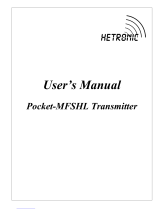
© 2017 EnOcean | www.enocean.com Sub GHz Transmitter Modules User Manual May 2017 | Page 3/35
USER MANUAL
PTM 330 / PTM 335 / PTM 330U / PTM 430J
Sub GHz Transmitter Modules
TABLE OF CONTENT
1 GENERAL DESCRIPTION ................................................................................. 4
1.1 Basic Functionality ......................................................................................... 4
1.2 Technical Data .............................................................................................. 5
1.3 Ordering Information ..................................................................................... 5
2 FUNCTIONAL DESCRIPTION ............................................................................ 6
2.1 Block diagram ............................................................................................... 6
2.2 Pin out ......................................................................................................... 7
2.3 Pin Description and operational characteristics .................................................. 8
2.4 Configuration Interface .................................................................................. 9
2.4.1 PTM 330 / PTM 330U Configuration .............................................................. 9
2.4.2 PTM 430J Configuration ............................................................................ 10
2.4.3 PTM 335 Configuration ............................................................................. 11
2.5 Absolute maximum ratings (non operating) .................................................... 15
2.6 Maximum Ratings (operating) ....................................................................... 15
2.7 Radio telegram ............................................................................................ 16
2.7.1 PTM 330, PTM 330U and PTM 335 Normal operation .................................... 16
2.7.2 PTM 430J Equipment Profile Examples ........................................................ 18
2.7.3 PTM 335 Secured Radio Message ............................................................... 20
2.7.4 PTM 335 Switching to Secure Mode and send Teach-In Telegrams ................. 20
2.7.5 User defined operation ............................................................................. 21
2.8 Transmit timing and operating rate ................................................................ 21
3 APPLICATIONS INFORMATION ....................................................................... 22
3.1 How to connect an energy harvester .............................................................. 22
3.2 How to generate an equivalent energy pulse ................................................... 23
3.3 How to solder additional teach-in button (PTM 335 only) ................................. 23
3.4 EMC and module handling ............................................................................ 24
3.5 Antenna ..................................................................................................... 25
3.6 Layout recommendations ............................................................................. 26
3.7 Device Integration ....................................................................................... 27
3.8 Transmission range ..................................................................................... 28
4 AGENCY CERTIFICATIONS ............................................................................ 29
4.1 Radio Equipment Directive (RED) for the European Union ................................. 29
4.2 FCC (United States) Certification ................................................................... 31
4.2.1 PTM 330U FCC APPROVAL ......................................................................... 31
4.3 ISED (former Industry Canada) Certification ................................................... 33
4.3.1 ISED Regulatory Statements ..................................................................... 34
4.4 Radio Certification for the Japanese Market ..................................................... 35
4.4.1 Label Information .................................................................................... 35




















